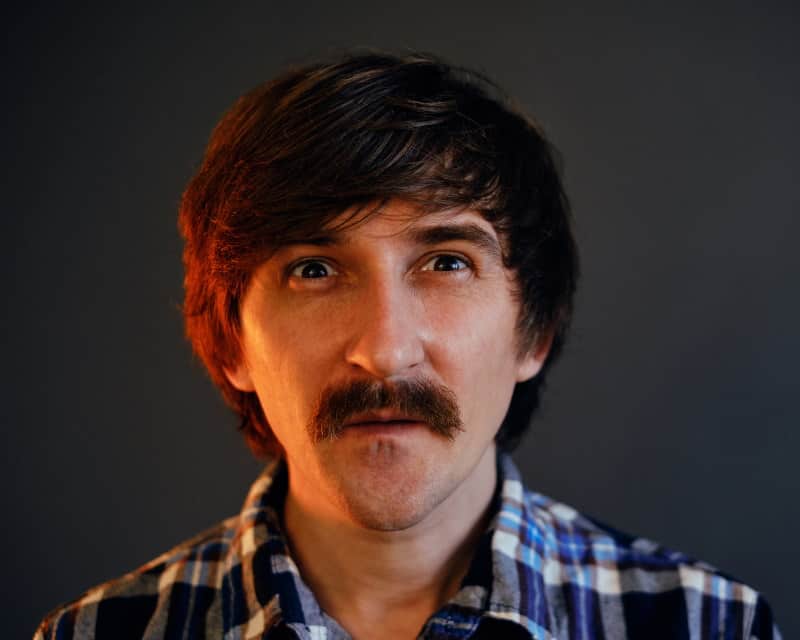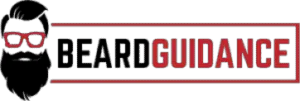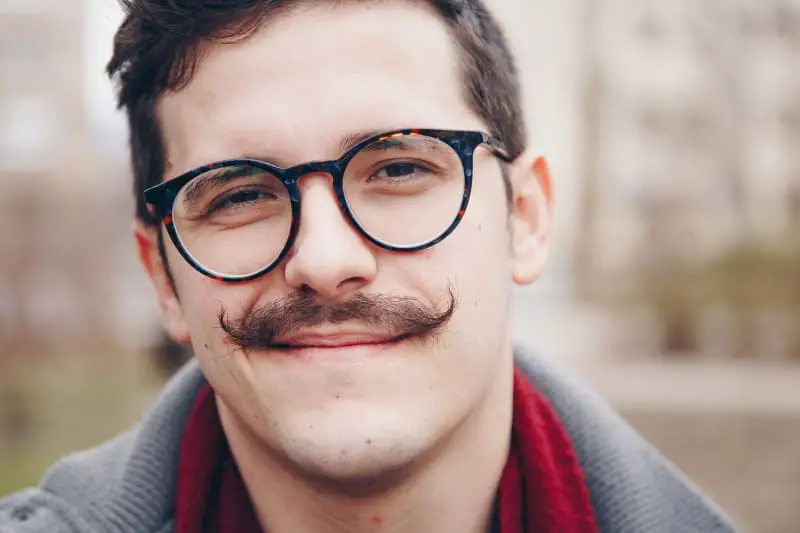Growing a mustache takes time and patience. When you’re first starting out it feels like it will never grow; then within a few weeks, you start to see a nice development and get a sense that you just can’t slow down your progress.
Only…that’s exactly what happens later. After a bit it just seems to settle on a certain length. Is something wrong here or does a mustache stop growing on its own?
Your mustache, along with the rest of your facial hair, does eventually stop growing. It reaches what is called “terminal length.” However, each person has a different terminal length due to their genetics. For most people this happens around the time their mustache would start to curl over and obscure their upper lip. Facial hair follows a cycle of growing, resting and shedding. If you have had a mustache for some time then percentage of the hairs, roughly a tenth of them, are in the shedding phase at any given moment. These fall out to make room for new hairs to grow in their place. So, a mustache will reach terminal length, but this doesn’t mean it stops growing—just that it stops growing longer.
Terminal length may determine how long your mustache will be, but the phases of hair growth and your genetics determine at what rate this happens. To learn more about these phases, terminal length and how to improve facial hair growth, keep reading. We’ll cover these topics and more.
The Phases of Mustache Growth and Terminal Length
Human hair growth is a fascinating topic. The primary factor in determining the rate of growth and the terminal length of hair is a person’s individual genetics, but sex, age, and nutrition all play a role.
We can’t control our genetics, so the largest factor is one that is outside of our control. However, we can improve our diets and workout to increase our testosterone, and both of these contribute to increased facial hair growth.
The First Phase
The first phase of hair growth is called the anagen phase. This is the part of the hair cycle in which it grows. After a fresh shave, it is the anagen phase that is responsible for giving you that five o’clock shadow you see in the evening.
This phase can last up to five years; although it is much, much shorter for some people. This is where genetics plays the biggest role. So long as your hair is growing, it is in this first phase. But once it reaches terminal length, it moves into the next phase of its lifecycle.
The Second Phase
The second phase is the catagen phase. This is where your hair settles on length. To stop further growth the hair follicle shrinks in size and the root of the hair “detaches.” This doesn’t mean that it leaves your face, but rather that inside of the dermal layer the root disconnects, almost like when you pull on a mustache hair too hard which we look at here.
This prevents blood from being able to flow to the root; and without the blood there is no energy for further growth. This actually makes your hair look a little bit longer because it isn’t seated as far back within the skin. But this extra length isn’t from growth, rather it comes from a repositioning of the hair follicle.
The Third Phase
The final stage is the telogen phase. It is in this part of the cycle that the hair follicle eventually falls out. However, this doesn’t happen right away. The telogen phase may actually start by first helping to anchor the hair in place better.
Eventually, the hair follicle will begin to grow again; but in order to do this, the hair separates from the root and falls out. The root can then start new growth, almost in the same fashion as it does after you shave. When this happens, the hair then returns to the anagen phase and the cycle begins all over again.
Each hair in your mustache experiences this cycle at its own pace. So, while your mustache doesn’t seem like it is growing, it technically always is. However, it is always growing to the point of terminal length and then starting over. We can’t change our genetics to increase our terminal length, but there is a secret most people don’t realize.
While terminal length is one point at which the length of hair settles, a poorly maintained mustache will slow down or even stop growing well before this length due to issues like split hair or lack of nutrition.
If your mustache stops growing and you don’t properly groom it, then you might not actually be at terminal length yet. Try the tips below to figure out if your growth stopped due to terminal length or lack of maintenance.
My Moustache Has Barely Even Started Growing, Yet I Think It’s Stopped. What Gives?
If your mustache hairs are still quite short, then it is unlikely that they have reached terminal length. Unlikely is the keyword here as terminal length is determined by genetics. Some people are unlucky and can only grow a very short mustache.
Still, the chances are good that you are experiencing the stop and start of facial hair growth. In this article we looked at whether or not different people’s facial hair grows at the same rate. Not only did we discover that the rate was different between people, but that one person will experience different rates of facial hair growth over the course of their lifetime.
Facial hair is a body hair which, unlike head hair, can stop and start growing when it likes. While you typically have a baseline rate of growth, this can slow down or speed up seemingly at random.
If your mustache has slowed down or stopped while it’s still small, then you are most likely experiencing one of these slow moments. Give it time and it’ll start growing again.
How Can I Repair Split Ends and Broken Hairs?
As this video shows, split ends and broken hairs are a common experience for many bearded men:
The problem with split ends is that they slow down and can even halt the growth of your facial hair. Unfortunately, repairing them doesn’t really happen. When we have split ends, our best choice is to trim them off.
While repairing is a bust, there are steps we can take to prevent damage. Using beard balm and beard oil helps to keep the hairs strong so that they don’t split. Combing your beard also helps them to stay together. Avoid using shampoo formulated for your head and pat dry your beard instead of reaching for the blow dryer.
Most of the time, trimming or shaving only serves to slow down facial hair growth. But if you are dealing with a lot of split ends, trimming the hairs will in fact increase the rate of growth.
I’ve Had a Longer Mustache in the Past But It Won’t Grow Now. What Do I Do?
First, don’t panic. As mentioned above, the rate of facial hair growth isn’t uniform. You could just be experiencing a slow period. If this is the case, then the only thing to do is to wait. Likewise, check for split ends and remove them accordingly. In the meantime, take a look at your diet.

Are you eating more sugars than normal? What about fatty foods? Are you getting enough vitamins and essential fatty acids? One of the biggest factors in the rate of facial hair growth is the foods that we put into ourselves. If we keep eating junk, we’re going to find that our facial hair grows slowly. If you’ve recently changed your diet, this might be the problem.
Why Doesn’t My Mustache Grow as Long as My Friend’s Mustache?
Genetics, mate. I wish there was a better answer for this, but some people’s genes let them grow long facial hairs while other people are stuck with shorter hairs. This isn’t a very helpful answer if you have mustache envy but it’s what science tells us.
However, before you resign yourself to a shorter mustache, you should try the steps above to see if there is something slowing down your growth beyond your genetics. When all else fails, try a beard growth supplement like this or an extra strength biotin application like Pure Research has formulated.
Conclusion
Your mustache, along with the rest of your facial hair, will reach a terminal length where it stops growing any longer. This does not mean that your mustache stops growing. This might not be what you wanted to hear if you were looking for advice on growing a longer mustache, but there is an important lesson to take away from this.
Since your facial hair is always in the process of going through the three phases of human hair growth, you should always consider your beard and mustache to be a work in progress even when it is full size. This means you must continue to look after it, groom it, and eat nutritious foods to keep up the rate of growth.
If you stop because you think it is done, you’ll find that your mustache looks to be thinning out as the anagen phase loses the resources it needs to grow quickly and the telogen phase sees what you do have shed. So, stay healthy, stay hairy, and keep growing.

